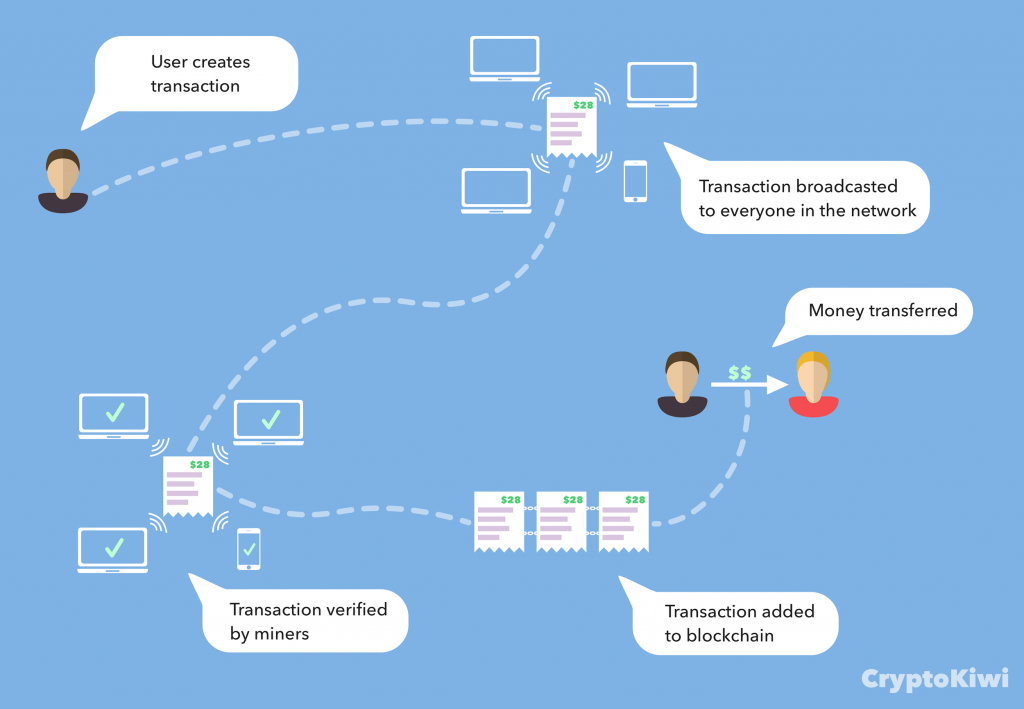Blockchains have a wide range of uses including accounting, storing medical records and cryptocurrencies. Cryptocurrencies use blockchain technology to eliminate the need for financial institutions, such as ASB, Visa and Mastercard, to act as trusted middlemen and instead allow users to transfer money to each other directly.
BASICS
Blockchain & Cryptocurrencies
The blockchain serves as a decentralised, publically accessible record of all transactions that have ever occurred on the network and is stored on many different computers. This ensures no single point of failure, one of the significant advantages of decentralisation over a centralised system. In a similar vein, governments cannot control the number of cryptocurrency coins in circulation, eliminating the possibility of inflation. Furthermore, there are no restrictions on making an account, and no one can withhold money from you like banks can.
To make up for this lack of a centralised authority, all transactions are sent to every person on the network to be independently verified. To try and understand this, imagine you are playing a game of ten-pin bowling. In a centralised system, the computer is trusted to record each player’s points accurately and keep track of the score. This contrasts with a decentralised system in which every player separately keeps track of the score, and at the end of each round, all players compare their records. If any player tried to cheat, all the other players would pick it up. A decentralised system removes the reliance on one party and makes mistakes much less likely. Furthermore, more participants result in higher decentralisation which makes it even harder to manipulate the records. In this analogy, when each player verifies the recorded score at the end of each round, they perform the role of miners.
Cryptocurrency miners, who can be anyone with a computer and an internet connection, use cryptography to verify transactions and make them irreversible. In exchange, miners receive a reward in the form of newly generated Bitcoin for doing so. This reward decreases approximately every four years until the limit of Bitcoin supply (about 21 million) is reached.
Advantages & Disadvantages of Cryptocurrency
Advantages
- Cheaper to send money – no banks to take fees
- Faster – no banks to process payments
- Borderless – easier to send money overseas
- Decentralised – no one to trust to make a payment
- Open source – anyone can check the code for manipulation
- Privacy – personal details are not shared when payments are made
- Secure – payment information is encrypted
Disadvantages
- Legislation – no tax guidance in New Zealand
- Price volatility – impacts ability to serve as a currency
- Adoption – cryptocurrencies have not yet reached mainstream adoption
Storing Your Cryptocurrencies
Cryptocurrency wallets do not store your currencies; instead, they interact with the blockchain to determine the amount of the currency tied to your personal and private keys. Cryptocurrency wallets are akin to online banking. Firstly, wallets show your account balance and transaction history and secondly, act as a terminal where you can send money. When a user creates a wallet, they are assigned two randomly generated strings of letters and numbers, known as keys.
There is a public key, which you give to people for them to pay you, similar to a bank account number. The other is the private key, which the wallet uses to authorise transactions, similar to a password. Your private key must never be lost and as the name suggests, must never be told to anyone, nor written down where people can see it. If you lose or forget your private key, your money is lost forever.
With this in mind, let us consider the five different types of wallets.
Online Wallets
Online wallets are websites that store your public and private keys to make them accessible from any computer. Because they are run by third parties and more susceptible to hackers, it is suggested you do not use online wallets to store large amounts of cryptocurrencies.
Desktop & Mobile Wallets
Desktop and mobile wallets are applications that are downloaded and stored on a device and store your public and private keys. Depending on the wallet, you either get a backup phrase to restore your private and public keys or a file that stores your keys and must be backed up.
Paper Wallets
Paper wallets are a printout of your public and private key, typically in the form of a QR code which can be quickly scanned by a mobile device when you want to send or receive payments. Due to their nature of being stored entirely offline, they are regarded as the safest option but are inconvenient for frequent transacting.
Hardware Wallets
Hardware wallets use a physical device about the size of a USB thumb drive to authorise payments. Similar to paper wallets, hardware wallets store private keys entirely offline on the device which makes them one of the safest options. Thanks to their software interface, they are much more convenient to use than paper wallets but do come at a cost. Two of the most popular hardware wallets are the Trezor and the Ledger Nano S. While both are widely accepted as one of the most secure ways of storing cryptocurrencies, Trezor is open-source whereas the Ledger Nano S isn’t.
The different types of wallets come with different characteristics and therefore are suited to different uses. When choosing a wallet, you should consider the following factors:
- Security
- Convenience
- Cost

